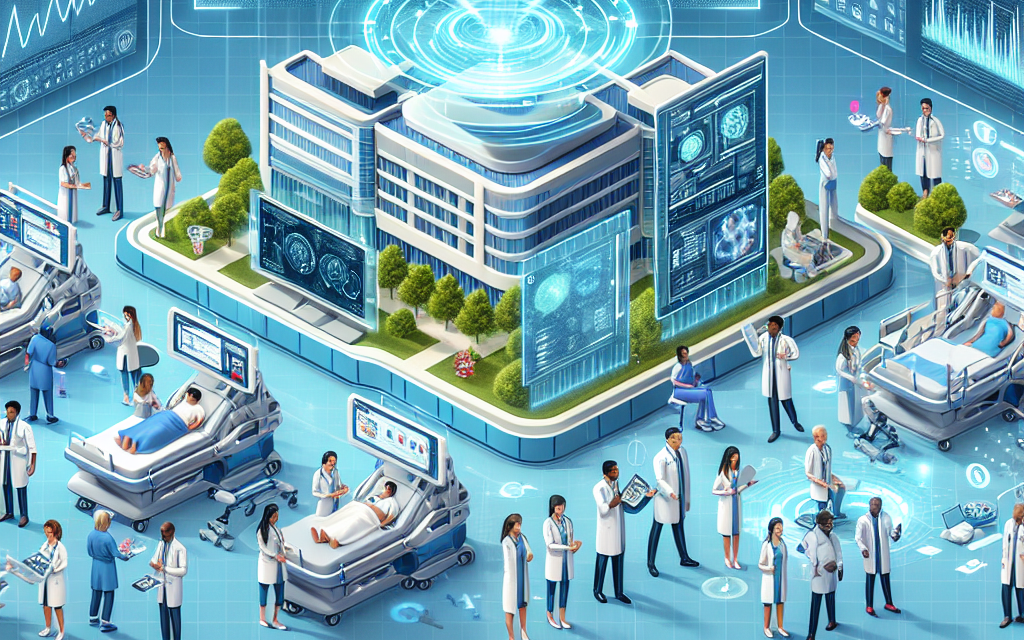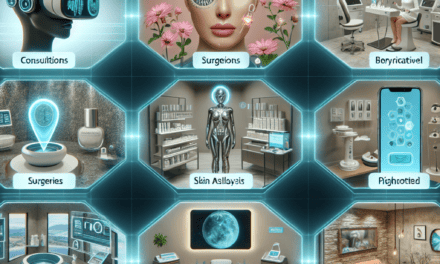Health Systems Focus on AI Efficiency and ROI by 2025
The integration of artificial intelligence (AI) into healthcare systems is rapidly transforming the landscape of medical services, patient care, and operational efficiency. As we approach 2025, health systems are increasingly focusing on AI to enhance efficiency and return on investment (ROI). This article delves into the various dimensions of AI in healthcare, exploring its potential to revolutionize health systems, improve patient outcomes, and drive financial performance.
1. Understanding AI in Healthcare
Artificial intelligence encompasses a range of technologies that enable machines to perform tasks that typically require human intelligence. In healthcare, AI applications can be broadly categorized into three areas: clinical decision support, operational efficiency, and patient engagement.
1.1 Clinical Decision Support
AI systems can analyze vast amounts of medical data to assist healthcare professionals in making informed decisions. For instance, machine learning algorithms can identify patterns in patient data that may not be immediately apparent to human clinicians. This capability is particularly valuable in diagnosing diseases, predicting patient outcomes, and personalizing treatment plans.
- Example: IBM Watson Health has developed AI tools that analyze medical literature and patient records to provide evidence-based treatment recommendations for oncologists.
- Case Study: A study published in the journal “Nature” demonstrated that an AI system could outperform human radiologists in detecting breast cancer in mammograms, highlighting the potential for AI to enhance diagnostic accuracy.
1.2 Operational Efficiency
AI can streamline administrative processes, reduce costs, and improve resource allocation within healthcare organizations. By automating routine tasks such as appointment scheduling, billing, and claims processing, health systems can free up staff to focus on more complex patient care activities.
- Example: The use of AI-powered chatbots for patient inquiries can significantly reduce the workload on administrative staff.
- Statistics: According to a report by McKinsey, AI could potentially save the healthcare industry up to $150 billion annually by 2026 through improved operational efficiencies.
1.3 Patient Engagement
AI technologies can enhance patient engagement by providing personalized health information and support. For example, AI-driven mobile applications can remind patients to take medications, track their health metrics, and offer tailored wellness advice.
- Example: Apps like MySugr use AI to help diabetes patients manage their condition by providing personalized insights based on their glucose levels and lifestyle choices.
- Case Study: A study published in “JAMA Internal Medicine” found that patients using AI-based health apps reported higher satisfaction levels and better adherence to treatment plans.
2. The Financial Implications of AI in Healthcare
As health systems invest in AI technologies, understanding the financial implications is crucial for justifying these investments. The ROI of AI in healthcare can be assessed through various metrics, including cost savings, revenue generation, and improved patient outcomes.
2.1 Cost Savings
AI can lead to significant cost savings for healthcare organizations by reducing operational inefficiencies and minimizing errors. For instance, automating administrative tasks can decrease labor costs and reduce the time spent on manual processes.
- Example: A hospital that implemented an AI-driven scheduling system reported a 30% reduction in appointment cancellations, leading to increased revenue and better resource utilization.
- Statistics: A report from Accenture estimates that AI applications could save the U.S. healthcare economy $150 billion annually by 2026.
2.2 Revenue Generation
AI can also contribute to revenue generation by enhancing service offerings and attracting more patients. For example, AI-driven diagnostic tools can enable healthcare providers to offer advanced services that differentiate them from competitors.
- Example: Telemedicine platforms that utilize AI for triaging patients can expand access to care, leading to increased patient volume and revenue.
- Case Study: A healthcare system that adopted AI for predictive analytics saw a 20% increase in patient retention rates, translating into significant revenue growth.
2.3 Improved Patient Outcomes
Investing in AI can lead to better patient outcomes, which can indirectly impact financial performance. Improved health outcomes can reduce readmission rates, lower malpractice claims, and enhance patient satisfaction—all of which contribute to a healthier bottom line.
- Example: AI algorithms that predict patient deterioration can enable timely interventions, reducing the likelihood of costly complications.
- Statistics: A study published in “Health Affairs” found that hospitals using AI for predictive analytics experienced a 15% reduction in readmission rates.
3. Challenges and Barriers to AI Adoption in Healthcare
Despite the promising potential of AI in healthcare, several challenges and barriers hinder its widespread adoption. Understanding these obstacles is essential for health systems aiming to leverage AI effectively.
3.1 Data Privacy and Security
One of the primary concerns surrounding AI in healthcare is data privacy and security. The sensitive nature of health information necessitates stringent measures to protect patient data from breaches and unauthorized access.
- Example: The Health Insurance Portability and Accountability Act (HIPAA) sets strict regulations on how patient data can be used and shared, complicating AI implementation.
- Statistics: According to a report by IBM, healthcare organizations experienced a 47% increase in data breaches in 2020, raising concerns about the security of AI systems.
3.2 Integration with Existing Systems
Integrating AI technologies with existing healthcare systems can be a complex and resource-intensive process. Many health systems rely on legacy systems that may not be compatible with modern AI solutions.
- Example: A hospital that attempted to integrate an AI diagnostic tool with its electronic health record (EHR) system faced significant challenges due to data format discrepancies.
- Case Study: A study published in “Journal of Medical Internet Research” highlighted that 60% of healthcare organizations reported difficulties in integrating AI with their existing IT infrastructure.
3.3 Resistance to Change
Resistance to change among healthcare professionals can impede the adoption of AI technologies. Many clinicians may be skeptical of AI’s capabilities or fear that it could replace their roles.
- Example: A survey conducted by the American Medical Association found that 40% of physicians expressed concerns about AI’s ability to make accurate clinical decisions.
- Statistics: According to a report by Deloitte, 70% of healthcare executives believe that cultural resistance is a significant barrier to AI adoption.
4. Future Trends in AI and Healthcare
As we look toward 2025, several trends are emerging in the intersection of AI and healthcare. These trends will shape the future of health systems and their approach to leveraging AI for efficiency and ROI.
4.1 Increased Personalization of Care
The future of healthcare will likely see a shift toward more personalized care driven by AI. By analyzing individual patient data, AI can help tailor treatment plans to meet the unique needs of each patient.
- Example: AI algorithms that analyze genetic information can enable precision medicine, allowing for targeted therapies based on a patient’s genetic makeup.
- Case Study: A healthcare organization that implemented AI-driven genomics analysis reported improved treatment outcomes for cancer patients through personalized therapy plans.
4.2 Expansion of Telehealth Services
The COVID-19 pandemic accelerated the adoption of telehealth services, and AI is poised to enhance these offerings further. AI can improve telehealth by providing real-time data analysis and decision support during virtual consultations.
- Example: AI-powered chatbots can assist patients in triaging their symptoms before a telehealth appointment, ensuring that they receive appropriate care.
- Statistics: A report by McKinsey found that telehealth usage stabilized at 38 times higher than pre-pandemic levels, indicating a lasting shift in patient preferences.
4.3 Enhanced Predictive Analytics
Predictive analytics powered by AI will become increasingly sophisticated, enabling healthcare providers to anticipate patient needs and allocate resources more effectively. This capability can lead to proactive care and improved patient outcomes.
- Example: AI algorithms that analyze historical patient data can predict which patients are at risk of developing chronic conditions, allowing for early interventions.
- Case Study: A healthcare system that implemented predictive analytics for patient readmission saw a 25% reduction in readmission rates within one year.
5. Conclusion: The Path Forward for AI in Healthcare
The focus on AI efficiency and ROI in healthcare systems by 2025 presents both opportunities and challenges. As health organizations navigate this landscape, several key takeaways emerge:
- Investment in AI is essential: To remain competitive and improve patient care, health systems must invest in AI technologies that enhance operational efficiency and clinical decision-making.
- Addressing challenges is crucial: Overcoming barriers such as data privacy concerns, integration issues, and resistance to change will be vital for successful AI adoption.
- Future trends will shape healthcare: The personalization of care, expansion of telehealth, and enhanced predictive analytics will define the future of healthcare, driven by AI innovations.
In conclusion, as health systems focus on AI efficiency and ROI by 2025, the potential for improved patient outcomes, operational efficiencies, and financial performance is immense. By embracing AI technologies and addressing the challenges that come with them, healthcare organizations can pave the way for a more efficient, effective, and patient-centered future.





